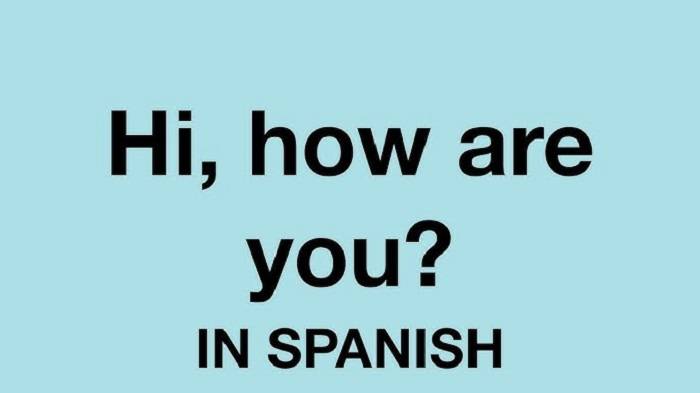Learning how to greet someone in a new language is one of the first and most important steps in becoming familiar with that language. Spanish, spoken by over 460 million people as their first language, is one of the most widely spoken languages in the world. Whether you’re traveling to a Spanish-speaking country, interacting with Spanish-speaking friends, or simply expanding your linguistic skills, knowing how to say “hi” and other greetings in Spanish is essential. This blog post will explore the various ways to say “hi” in Spanish, the contexts in which they are used, and how these greetings reflect the rich cultural diversity of the Spanish-speaking world.
The Basics: Saying “Hi” in Spanish
Hola – The Universal Greeting
The most common and straightforward way to say “hi” in Spanish is “Hola.” Pronounced “OH-lah,” this greeting is universally recognized across all Spanish-speaking countries. “Hola” can be used in virtually any situation, whether you’re greeting a friend, a colleague, or even a stranger. It’s informal yet polite, making it the perfect greeting for most everyday interactions.
Example:
- Hola, ¿cómo estás? (Hi, how are you?)
Buenos Días – Good Morning
While “Hola” is a great all-purpose greeting, it’s also important to know the time-specific greetings in Spanish. “Buenos días,” pronounced “BWEH-nohs DEE-ahs,” means “good morning” and is used from early morning until around noon. It’s a polite and slightly more formal way to greet someone at the start of the day.
Example:
- Buenos días, señor García. (Good morning, Mr. García.)
Buenas Tardes – Good Afternoon
After noon, the appropriate greeting changes to “Buenas tardes,” which means “good afternoon.” Pronounced “BWEH-nahs TAR-des,” this greeting is used from noon until the early evening. It’s a standard way to greet someone during the middle of the day.
Example:
- Buenas tardes, ¿cómo le va? (Good afternoon, how are you?)
Buenas Noches – Good Evening/Night
In the evening and at night, you would greet someone with “Buenas noches,” which means “good evening” or “good night.” Pronounced “BWEH-nahs NOH-chess,” this phrase can be used both as a greeting and as a way to say goodbye at the end of the day.
Example:
- Buenas noches, nos vemos mañana. (Good night, see you tomorrow.)
Informal Greetings in Spanish
¡Qué Tal! – What’s Up?
For more casual encounters, especially among friends or peers, “¡Qué tal!” is a popular choice. Pronounced “KEH tahl,” this greeting is similar to saying “What’s up?” or “How’s it going?” in English. It’s informal and often used when you’re not just saying hi, but also checking in on how someone is doing.
Example:
- ¡Qué tal, amigo! (What’s up, my friend!)
¡Hola, Qué Pasa! – Hi, What’s Happening?
Another informal greeting is “¡Hola, qué pasa!” which translates to “Hi, what’s happening?” Pronounced “OH-lah, KEH PAH-sah,” this phrase is similar to “What’s up?” and is commonly used among younger people. It’s a bit more casual than “¡Qué tal!” and often implies that you’re interested in what’s going on in the other person’s life.
Example:
- ¡Hola, qué pasa! ¿Todo bien? (Hi, what’s happening? All good?)
¡Ey! – Hey!
In certain Spanish-speaking regions, particularly in informal or youthful settings, you might hear “¡Ey!” as a greeting. Pronounced “AY,” this is the Spanish equivalent of “Hey!” and is used to get someone’s attention or greet them casually.
Example:
- ¡Ey, tú! ¿Qué haces aquí? (Hey, you! What are you doing here?)
¿Cómo Andas? – How’s It Going?
“¿Cómo andas?” is another casual way to say “hi” in Spanish. Pronounced “KOH-moh AHN-dahs,” this phrase translates to “How are you walking?” but is understood as “How’s it going?” or “How are things?” It’s an informal greeting that you might use with friends or close acquaintances.
Example:
- ¿Cómo andas? Hace tiempo que no te veo. (How’s it going? I haven’t seen you in a while.)
Regional Variations in Spanish Greetings
Spanish is spoken in many countries across the world, and each region has its own unique expressions and ways of greeting. While “Hola” is universally understood, there are local variations that reflect the cultural diversity of the Spanish-speaking world.
Argentina and Uruguay – ¡Che!
In Argentina and Uruguay, you’ll often hear the word “¡Che!” as part of a greeting. Pronounced “CHAY,” “che” is a slang term that can mean “hey” or “mate,” and is used informally to address someone, often as a precursor to “Hola” or “¿Qué tal?”
Example:
- ¡Che, qué hacés! (Hey, what are you doing!)
Mexico – ¡Órale!
In Mexico, you might hear “¡Órale!” as an informal greeting or exclamation. Pronounced “OH-rah-leh,” “órale” is a versatile expression that can mean “come on,” “hurry up,” or “wow,” depending on the context. It’s often used to show excitement or surprise, and can also be a way to greet someone enthusiastically.
Example:
- ¡Órale, compadre! ¿Cómo te va? (Hey, buddy! How’s it going?)
Spain – ¡Buenas!
In Spain, especially in more casual settings, people might greet each other with “¡Buenas!” This is a shortened form of “buenos días,” “buenas tardes,” or “buenas noches,” and can be used at any time of day. It’s an informal, friendly way to say “hi.”
Example:
- ¡Buenas! ¿Qué tal tu día? (Hi! How’s your day going?)
Colombia – ¿Quiubo?
In Colombia, you might hear “¿Quiubo?” as a greeting. Pronounced “KEE-oo-boh,” this is a contraction of “¿Qué hubo?” which literally means “What was there?” but is understood as “What’s up?” It’s a casual greeting commonly used among friends.
Example:
- ¿Quiubo, parcero? (What’s up, buddy?)
Venezuela – ¡Chamo!
In Venezuela, “¡Chamo!” or “¡Chama!” (for females) is often used as a greeting, particularly among younger people. Pronounced “CHAH-mo” or “CHAH-ma,” this term is a colloquial way of saying “boy” or “girl,” and is similar to saying “dude” or “buddy” in English.
Example:
- ¡Chamo, cuánto tiempo sin verte! (Hey, dude, long time no see!)
Polite and Formal Greetings
¿Cómo Está Usted? – How Are You? (Formal)
In more formal situations, such as when addressing someone older, in a professional setting, or when meeting someone for the first time, it’s important to use a polite greeting. “¿Cómo está usted?” pronounced “KOH-moh ess-TAH oos-TEHD,” is the formal way of asking “How are you?” in Spanish.
Example:
- Buenos días, señor Rodríguez. ¿Cómo está usted? (Good morning, Mr. Rodríguez. How are you?)
Muy Buenos Días/Tardes/Noches – A Very Good Morning/Afternoon/Evening
For added politeness, you can emphasize the greeting by saying “Muy buenos días/tardes/noches,” which translates to “A very good morning/afternoon/evening.” This is often used in formal or respectful contexts.
Example:
- Muy buenas tardes, doctora. ¿Cómo se encuentra hoy? (A very good afternoon, doctor. How are you today?)
Es Un Placer Conocerle – It’s a Pleasure to Meet You
When meeting someone for the first time, you might want to add a polite phrase like “Es un placer conocerle,” pronounced “ess oon plah-SEHR koh-noh-SER-leh,” which means “It’s a pleasure to meet you.” This is a formal and respectful way to greet someone new.
Example:
- Hola, es un placer conocerle. (Hi, it’s a pleasure to meet you.)
Cultural Insights on Spanish Greetings
The Importance of Greetings in Spanish Culture
In many Spanish-speaking cultures, greetings are more than just a way to say “hi.” They are an essential part of social interactions, reflecting respect, warmth, and a sense of community. It’s common to greet everyone when entering a room, whether it’s a small gathering or a larger event. In some cultures, not greeting someone properly can be seen as impolite or disrespectful.
The Role of Physical Touch
Physical touch often accompanies greetings in Spanish-speaking cultures. In many countries, a kiss on the cheek, a hug, or a firm handshake is customary when saying “hi,” especially among friends and family. The number of cheek kisses can vary by region; for example, in Spain, it’s common to give two kisses (one on each cheek), while in Argentina, a single kiss is more typical.
Addressing People by Their Titles
In formal situations, it’s important to address people by their titles, such as “Señor” (Mr.), “Señora” (Mrs.), or “Señorita” (Miss). Using titles is a sign of respect, particularly when interacting with elders, professionals, or strangers. This practice is especially important in countries where formalities are highly valued, such as in Spain and parts of Latin America.
The Use of “Tú” and “Usted”
The distinction between “tú” (informal “you”) and “usted” (formal “you”) is crucial in Spanish greetings. “Tú” is used when addressing friends, family, or peers, while “usted” is reserved for formal or respectful interactions. Using the correct form shows an understanding of social hierarchies and cultural norms.
Example:
- ¿Cómo estás? (informal) – How are you?
- ¿Cómo está usted? (formal) – How are you?
Expanding Your Vocabulary: Other Common Spanish Greetings
¿Qué Hay de Nuevo? – What’s New?
“¿Qué hay de nuevo?” pronounced “KEH aye deh NWEH-voh,” is a friendly way to ask “What’s new?” It’s a casual greeting that invites the other person to share any recent news or updates.
Example:
- Hola, ¿qué hay de nuevo? (Hi, what’s new?)
¿Qué Cuentas? – What’s Going On?
“¿Qué cuentas?” pronounced “KEH KWEN-tahs,” literally means “What do you tell?” but is understood as “What’s going on?” This greeting is informal and commonly used among friends or acquaintances.
Example:
- ¿Qué cuentas? Hace tiempo que no hablamos. (What’s going on? It’s been a while since we talked.)
¡Tanto Tiempo! – Long Time No See!
When greeting someone you haven’t seen in a while, you might say “¡Tanto tiempo!” pronounced “TAHN-toh TYEHM-poh,” which means “Long time no see!” It’s a warm, informal way to reconnect with someone.
Example:
- ¡Tanto tiempo! ¿Cómo has estado? (Long time no see! How have you been?)
FAQs
What is the most common way to say “hi” in Spanish?
The most common way to say “hi” in Spanish is “Hola.”
How do you say “good morning” in Spanish?
“Good morning” in Spanish is “Buenos días.”
What are some informal ways to greet someone in Spanish?
Informal greetings include “¡Qué tal!” (What’s up?), “¡Hola, qué pasa!” (Hi, what’s happening?), and “¡Ey!” (Hey!).
How do you greet someone formally in Spanish?
A formal greeting would be “Buenos días” (Good morning) followed by “¿Cómo está usted?” (How are you?).
Are there different greetings in Spanish depending on the region?
Yes, there are regional variations such as “¡Che!” in Argentina, “¡Órale!” in Mexico, and “¿Quiubo?” in Colombia.
Learning how to say “hi” in Spanish opens the door to engaging with the vibrant and diverse cultures of the Spanish-speaking world. Whether you’re using the universal “Hola,” opting for a time-specific greeting like “Buenos días,” or embracing regional expressions like “¡Che!” or “¡Órale!,” these greetings help you connect with others in a meaningful way.
As you continue to explore the Spanish language, remember that greetings are just the beginning. They set the tone for your interactions and reflect the warmth, respect, and friendliness that are hallmarks of Spanish-speaking cultures. So, the next time you meet a Spanish speaker, confidently say “Hola” and enjoy the connection that follows.




